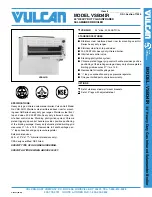
4
The Cadet Heating Boiler - How it works...
1. Heat
exchanger
Allows system water to flow through specially designed
coils for maximum heat transfer, while providing
protection against flue gas corrosion. The coils are
encased in a jacket that contains the combustion process.
2. Combustion
chamber
access
cover
Allows access to the combustion side of the heat
exchanger
coils.
3. Blower
The blower pulls in air and gas through the venturi (item
5). Air and gas mix inside the blower and are pushed into the
burner, where they burn inside the combustion chamber.
4. Gas
valve
The gas valve senses the negative pressure created by the
blower, allowing gas to flow only if the gas valve is
powered and combustion air is flowing.
5. Venturi
The venturi controls air and gas flow into the burner.
6. Flue gas sensor (limit rated)
This sensor monitors the flue gas exit temperature. The control
module will modulate and shut down the boiler if flue gas
temperature gets too hot. This protects the flue pipe from
overheating.
7. Boiler outlet temperature sensor (limit rated)
This sensor monitors boiler outlet water temperature (system
supply). The control module will adjust boiler firing rate so the
outlet temperature is correct.
8. Boiler
inlet
temperature
sensor
This sensor monitors return water temperature (system
return).
9. Temperature and pressure gauge (field installed, not
shown)
Monitors the outlet temperature of the boiler as well as the
system water pressure.
10. Electronic LCD display
The electronic display consists of 4 buttons, and a liquid crystal
display. The display is used to make adjustments and read
boiler
status.
11. Flue pipe adapter
Allows for the connection of the vent pipe system to the
boiler.
12. Burner (not shown)
Made with metal fiber and stainless steel construction,
the burner uses pre-mixed air and gas and provides a
wide range of firing rates.
13. Water outlet (system supply)
The water outlet is the water connection for water leaving the
boiler and entering the system.
14. Water inlet (system return)
The water inlet is the water connection for water entering the
boiler from the system.
15. Gas connection pipe
Threaded pipe connection of 1/2". This pipe should be
connected to the incoming gas supply for the purpose of
delivering gas to the boiler.
16. Boiler control module
The boiler control responds to internal and external signals
and controls the blower, gas valve, and pumps to meet the
demand.
17. Air intake adapter
Allows for the connection of the air intake pipe to
the
boiler.
18. High voltage junction box
The junction box contains the connection points for the line
voltage power and all pumps.
19. Manual air vent
Designed to remove trapped air from the heat exchanger
coils.
20. Low voltage connection board
The connection board is used to connect external low voltage
devices.
21. Low voltage wiring connections (knockouts)
Conduit connection points for the low voltage
connection
board.
22. Condensate drain connection
The condensate drain connection provides a connection
point to install a condensate drain line.
23. Front access cover
Provides access to all internal components.
24. Ignition electrode
Provides direct spark for igniting the burner.
25. Flame inspection window
The quartz glass window provides a view of the burner
surface and flame.
26. Gas shutoff valve
Manual valve used to isolate the gas valve from the gas supply.
27. Relief valve
Protects the heat exchanger from an over pressure condition.
The relief valve provided with the unit is set at 30 psi.
28. Flame sensor
Used by the control module to detect the presence of burner
flame.
29. Line voltage wiring connections (inside junction box)
Conduit connection points for the high voltage junction box.
30. Air pressure switch
The air pressure switch detects blocked inlet conditions.
31. Transformer
The transformer provides 24V power to the integrated control.
32. Heat exchanger thermal fuse (not shown)
Thermal fuse which detects abnormal flue temperatures in the
event there’s no water or water circulation.
Installation & Service Manual
CAUTION
In the event the thermal fuse opens, the heat
exchanger MUST BE replaced.





































